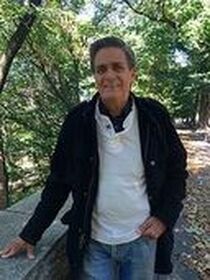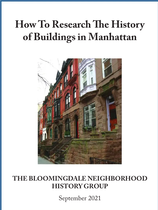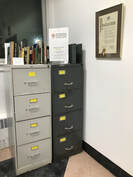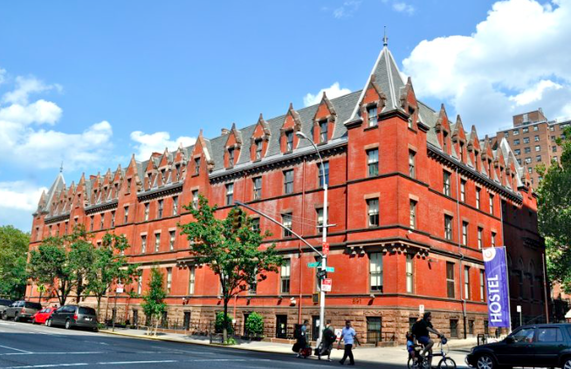

Summer Cool in Bloomingdale
We’re well into the summer season in Bloomingdale and we’ve noted a choice of “cool” things to do in this edition of Bloomingdale Bulletin. Stop by the beautiful Firemen’s Memorial with its fountain at Riverside Drive and 100th Street. Or pay a visit to Tanner’s spring in Central Park, once you read the odd story of the person it’s named after. Then check out how the quaint custom of crushing straw hats at the end of the summer season turned into a hooligan riot in The Straw Hat Rebellion of 1922. We look forward to feedback, comments, and ideas here. We hope you enjoy it all and will choose to support us with a donation. To view this and previous newsletters, go to our BULLETINS page.
At our PAST EVENTS page watch video of the June 27 presentation
"When Squatting Became Homesteading: Urban Renewal and Sweat Equity in Manhattan Valley" presented by Jennifer Maya Luz Pliego Save the Date, September 25, 2024 for a Free BNHG presentation

On Wednesday September 25th, Alexander Stille, the author of The Sullivanians : Sex, Psychotherapy and the Wild Life of an American Commune, will present a program based on his book, a "narrative history of a little-known and singular chapter of the American counterculture." The story Stille tells includes details about the lives of the group’s founders, leaders and their followers which included bold-faced names such as Jackson Pollock, the art critic Clement Greenberg, Judy Collins and the dancer Lucinda Childs. The group's communes were on the Upper West Side, including one particularly active one located in a multi-story building on West 91st Street
Free Walking Tours of Historic Bloomingdale
Wednesday, July 17th at 6pm Wednesday, September 25 at 6pm  Jim Mackin Jim Mackin
Meet at south end of Straus Park,
Broadway at W.106th Street No reservations needed Explore the history of the Upper West Side between W.96th and W.110th Streets Led by renowned local historian, Jim Mackin More Information at our UPCOMING EVENTS page The Latest Blog is now available on the BLOGS page
The Bicycle Craze Comes to Bloomingdale written by Pam Tice, member of BNHG planning committee In the 1890s, a bicycling craze swept America as men and women purchased bicycles and took to the roads. The safety bicycle, a machine much like the one we have today with equal-size wheels and inflated tires, fueled the craze as the model became widely available by the mid-1880s. Bicycles cost from $45 to $75, making the craze very much a middle-class phenomenon.
In our Bloomingdale neighborhood, with its paved roadways and two parks, the bicycle craze became part of street life. Read this and other essays of interest on our BLOGS page Bloomingdale Neighborhood History Group Receives Award
On May 19, 2024 the Three Parks Independent Democrats presented the inaugural Cynthia L. Doty Community Service Award to the BNHG "for its invaluable work capturing the history of our neighborhood in public programs and presentations regarding the buildings lining the streets and avenues from West 96th Street to 110th Street." UPCOMING BLOOMINGDALE LIBRARY EXHIBIT
August 1 through October 31, 2024 "The 1909 Hudson-Fulton Celebration New York City’s Biggest Party Event" An exhibit by Rob Garber for the Bloomingdale Neighborhood History Group Op Sail 76? Lindbergh’s ticker-tape parade? Big, but arguably New York’s greatest public spectacle was the now-forgotten Hudson-Fulton event in the Fall of 1909. It was a celebration of human flight, the electrification of cities, and—by the way— Hendrik Hudson’s “discovery” of New York Harbor and Robert Fulton’s invention (ish) of the steamboat. The two-week extravaganza lit up the East River bridges and culminated in a parade up Fifth Avenue, but the heart of the Hudson-Fulton Celebration was the Bloomingdale/Morningside Heights neighborhood, with a mammoth water gate at 110th Street and Orville Wright thrilling millions with his unprecedented flight past Grant’s Tomb. The Bloomingdale Library
West 100th Street between Amsterdam and Columbus Avenues (across from the 24th precinct station house) Mon-Tue 10am-7pm | Wed-Thu 11am-7pm|Fri-Sat 10am-5pm Catch up with Rob Garber's previous library exhibits, see our website pages:
"Eclipse!" March-April 2024 "The Old Community" December 2023-February 2024 "Bloomingdale As It Never Was (But Might Have Been)" September-November 2023 "Bloomingdale and Manhattan in 1927" June-August 2023 "History of the Police in Bloomingdale" March-May 2023 |
We’re reaching out to our Bloomingdale community for your support through a tax-deductible donation.
We are a group of neighbors who banded together 23 years ago to explore the history of our region of the Upper West Side, roughly 96th to 110th Streets --- an area historically known as Bloomingdale. Our numerous public programs are free and open to all. Last year, both in-person and online, we gave presentations about our neighborhood buildings, how they were built, and even what happens when they are taken apart. We taught neighbors how to do local history research in general and then shared how two local historians researched their 100-year-old buildings. We spent an evening together with local residents looking at old maps of Manhattan. At the Bloomingdale Library, we presented displays on the history of the West 100th Street police precinct, how the neighborhood looked in 1927, and local building projects planned but never built. We wrote about the history of our area before it was made accessible by Bloomingdale Road, taking you back to 1668, and then presented a “census picture” of who lived here in 1855. To help us please click the "Donate now" button. For more Information visit our DONATE page BNHG’s downloadable digital brochure:
How To Research the History of Buildings in Manhattan 
Whether you’re a student, researcher or simply someone interested in finding out the history of any building in Manhattan, there’s now a free guide that will help you to get started. How to Research the History of Buildings in Manhattan, includes links to free online sources of data on individual buildings, their physical characteristics, the date of their construction and the name of their designer
To assist in your own research, click on the BNHG Building Database, which is the product of more than three years of research and field work by BNHG members, led by Gilbert Tauber. The table lists all of the 1,056 buildings in the area from the north side of 96th Street to the south side of 110th Street between Central Park West and Riverside Drive. A Video Overview of the BNHG
If a picture is worth a thousand words, is a video likely to be worth even more? We think so, which is why a few members of the planning committee of the Bloomingdale Neighborhood History Group (BNHG} got together to produce this ten minute video. It's an introduction to the neighborhood that is our home, the neighborhood that inspires our research and is the inspiration for the free public programs we offer throughout the year.
Find out more about the BNHG at our ABOUT US page Reopening of the Bloomingdale Branch Library
and availability of the BNHG Library Collection! 
Our public archive of documents related to the history of the neighborhood is back at the Bloomingdale branch of the New York Public Library, on West 100th Street between Amsterdam and Columbus Avenues. The files are easy to find now, near the circulation desk, and they are chock-full of interesting material. Whether you are researching a specific topic or just browsing, you're welcome to copy pages in the library or to take a folder to one of the tables to read through it in comfort. On top of the filing cabinets you'll find an eclectic selection of books about NYC history donated by historian Peter Salwen, which are also for reading and reference use in the library. The Bloomingdale Library's own webpage is here, and a few highlights of our collection are posted digitally here.
Check out our Resources pages.
At our Resources pages you'll find fascinating Bloomingdale history under the following headings: Sources of Historical Information Useful Links and Resources Paterno Archive Bookshelf 2020 Project NYT Articles about Manhattan Valley from 1865-1998 Peter Salwen Collection Upper West Side History Quiz 
PRESERVING NEIGHBORHOOD HISTORY
The New York Preservation Archive Project was organized in 1990 to “preserve preservation history.” Every effort to save an historic building or place has a story. NYPAP exists to provide an archival record of the people involved, their victories and defeats, and the many documents that tell the story of each place. Thanks to Pam Tice (member of the BNHG planning committee) , the story of 891 Amsterdam Avenue is now a part of that record. You can review the story of our neighborhood’s landmark, which began as the Association for the Relief of Respectable Aged Indigent Females, and is now Hostelling International-New York City. The record is preserved at the NYPAP site here. To receive email notification of upcoming monthly presentations and seasonal bulletins, please share your email at our CONTACT US page. Of course, we will not give your information to others.
The content of this website is offered for educational purposes; You may not reproduce, distribute, copy, sell or otherwise use any portion of this website for political or commercial purposes. If you know the identity of people depicted in historical photographs reproduced here, we’d love to hear from you.
| ||





